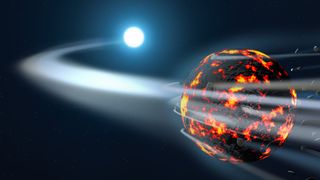We still have a lot to learn about our solar system’s childhood. Since we can’t go back to the beginning, astronomers rely on other stars for insight into the early years of how stars and their planets are made.
Recently, a team of astronomers found evidence that stars and planets actually grow up together, forming at the same time in a solar system’s life.

An artist’s depiction of a large asteroid breaking up and falling into a white dwarf. (Image credit: Amanda Smith)
“We have a pretty good idea of how planets form, but one outstanding question we’ve had is when they form: does planet formation start early, when the parent star is still growing, or millions of years later?” Amy Bonsor, an astronomer at Cambridge University in the U.K. and lead author of the new research, said in a statement.
Interestingly, their clues for planets’ infancy came from an unexpected place — the dead core of a former sun-like star, known as a white dwarf. White dwarfs are generally made of only hydrogen and helium, but they can be “polluted” when an asteroid or other rocky body falls into them. Astronomers can then analyze what the asteroids were made of by looking at the composition of the newly-polluted white dwarf.
“Some white dwarfs are amazing laboratories, because their thin atmospheres are almost like celestial graveyards,” Bonsor said.
Many of the 200 white dwarfs the team observed were rich in iron, pointing to iron-rich asteroids. To give an asteroid an iron core, things need to be pretty warm, and the most likely source of heat is the decay of a radioactive form of aluminum.
But this material, known as aluminum-26, can only exist for a little less than a million years — a blink of an eye in the timescale of the universe — before it decays away. So, in order for these asteroids to contain as much iron as the astronomers detected in the white dwarfs, these space rocks had to have formed pretty early, at the same time as the star itself was being made.
“This is just the beginning,” Bonsor said. “Every time we find a new white dwarf, we can gather more evidence and learn more about how planets form.”
The research is described in a paper published Monday (Nov. 14) in the journal Nature Astronomy.
Join our Space Forums to keep talking space on the latest missions, night sky and more! And if you have a news tip, correction or comment, let us know at: [email protected].





